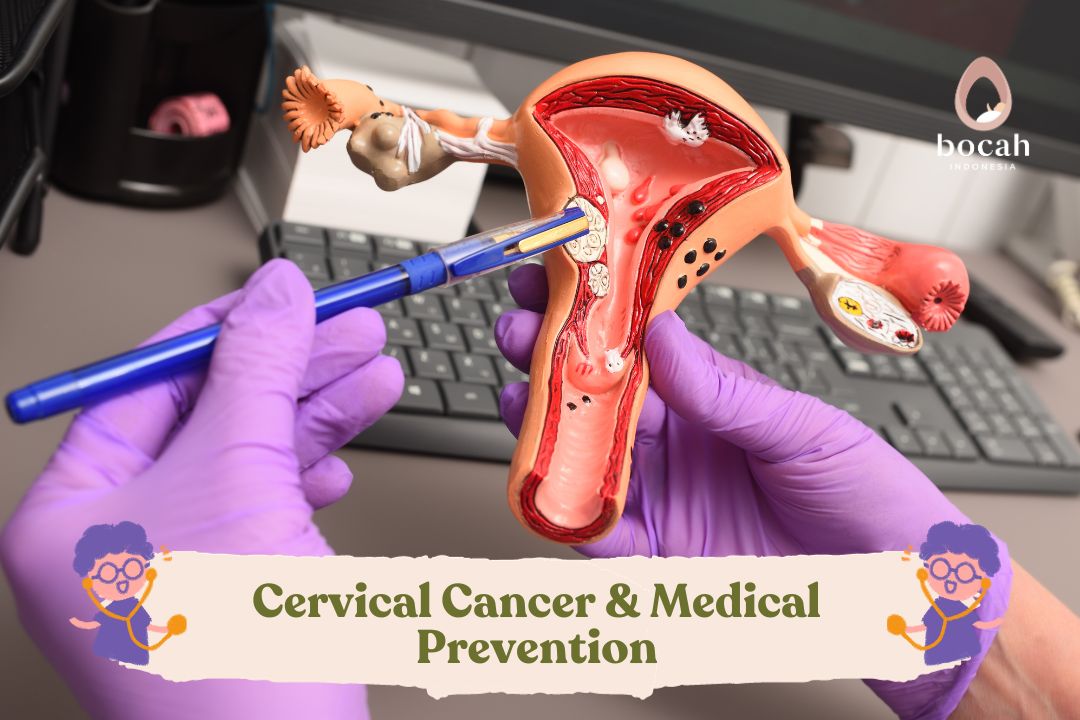Types of Cervical Cancer and Medical Prevention

Cervical cancer is a dangerous disease that is often overlooked. Learn about its symptoms and prevention methods through this article.
The cervix is the lower part of the uterus that extends into the upper part of the vagina. The uterus is covered by tissue composed of cells. These healthy cells can grow and undergo changes to become pre-cancerous cells.
Although not all pre-cancerous cells will turn into cancer, identifying problematic cells and treating them promptly is the right step to prevent cervical cancer.
Causes of Cervical Cancer
Most cases of cervical cancer are caused by the human papillomavirus (HPV), which can be sexually transmitted. This is the same virus that causes genital warts.
There are approximately 100 different types of HPV, but only certain types can cause cervical cancer. The two most common types that cause cancer are HPV-16 and HPV-18.
Tanya Mincah tentang Promil?
If someone is infected with an HPV type that can cause cancer, it does not necessarily mean they will develop cervical cancer. In general, a healthy immune system can clear most HPV infections, often within 2 years.
HPV can also cause other types of cancer in both women and men, including:
- Vulvar cancer
- Vaginal cancer
- Penile cancer
- Anal cancer
- Rectal cancer
- Throat cancer
Symptoms of Cervical Cancer
Some women may not realize they have cervical cancer because the disease at an early stage usually does not produce symptoms. Even when early symptoms appear, the disease is often mistaken for common conditions like menstruation and urinary tract infections (UTIs).
Typical symptoms of cervical cancer include:
- Abnormal bleeding, such as between periods, after intercourse, or after menopause.
- Unusual vaginal discharge that looks or smells different from usual.
- Pelvic pain.
- Frequent urination.
- Painful urination.
If you experience any of these symptoms, consult a doctor immediately for an accurate diagnosis.
Stages of Cervical Cancer
After a cervical cancer diagnosis, the doctor will determine the cancer’s stage. Staging indicates whether cancer has spread and, if so, how far it has spread. Determining the cancer stage can help the doctor find the appropriate treatment.
Cervical cancer has four stages:
- Stage 1: The cancer is small, possibly involving lymph nodes but not spreading to other parts of the body.
- Stage 2: The cancer is larger, possibly extending beyond the uterus and cervix or involving lymph nodes but not spreading to other body parts.
- Stage 3: The cancer has spread to the lower vagina or the pelvic wall, possibly blocking the ureters, tubes that carry urine from the kidneys to the bladder, but not spreading to other body parts.
- Stage 4: The cancer may have spread beyond the pelvis to organs like the lungs, bones, or liver.
Risk Factors for Cervical Cancer
HPV is the most significant risk factor for cervical cancer. Other factors that can increase the risk of developing cervical cancer include:
- HIV infection
- Chlamydia infection
- Active smoking
- Obesity
- Family history of cervical cancer
- Low fruit and vegetable intake
- Use of contraceptive pills
- First pregnancy at age under 17
Having one or more of these factors does not guarantee cervical cancer. Learn what you can do now to reduce your risk.
Cervical Cancer Prevention
One of the easiest ways to prevent cervical cancer is by undergoing regular Pap smear or HPV tests. These screenings can detect pre-cancerous cells, allowing for early treatment before they become cancerous.
HPV infection causes the majority of cervical cancer cases. This infection can be prevented with the Gardasil and Cervarix vaccines. Vaccination is most effective before an individual becomes sexually active. Both boys and girls can be vaccinated against HPV.
Here are some other ways to reduce the risk of HPV and cervical cancer:
- Avoid having multiple sexual partners.
- Use condoms during sexual intercourse.
Remember that prevention is always better than treatment. Find more information about other health issues such as infertility or pregnancy programs at Bocah Indonesia.
Source:
- American College of Obstetricians and Gynecologists. Cervical Cancer Screening. Diakses 2023. https://www.acog.org/womens-health/faqs/cervical-cancer-screening
- American Cancer Society. Cervical Cancer. Diakses 2023. https://www.cancer.org/cancer/cervical-cancer.html
- Centers for Disease Control and Prevention. Cervical Cancer. Diakses 2023. https://www.cdc.gov/cancer/cervical/index.htm
- Centers for Disease Control and Prevention. Human Papillomavirus (HPV) Vaccine. Diakses 2023. https://www.cdc.gov/vaccinesafety/vaccines/hpv-vaccine.html
- National Cancer Institute. Cervical Cancer – Patient Version. Diakses 2023. https://www.cancer.gov/types/cervical
- World Health Organization. Cervical Cancer. Diakses 2023. https://www.who.int/health-topics/cervical-cancer


